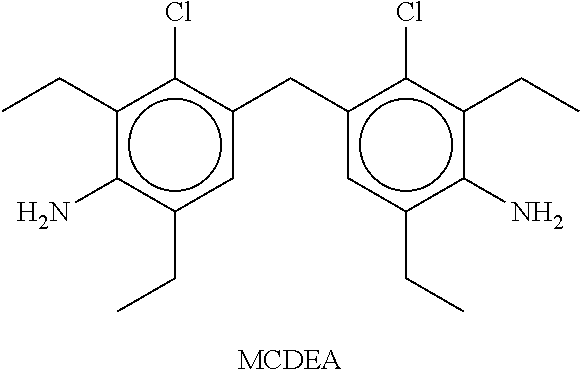Shoe press belt
a shoe press and belt technology, applied in the field of belts, can solve the problems of deterioration of the mechanical and dynamical characteristics of polyurethane, damage to the belt beyond usability, and increase the temperature inside the shoe press belt, so as to achieve good dynamic and mechanical properties, good heat resistance, and widen the effect of operating temperature rang
- Summary
- Abstract
- Description
- Claims
- Application Information
AI Technical Summary
Benefits of technology
Problems solved by technology
Method used
Image
Examples
Embodiment Construction
[0018]The invention provides a novel shoe press belt for use, characterized in that it comprises polyurethane polymer prepared of a urethane prepolymer containing isocyanate groups and a chain extender, the urethane prepolymer being prepared using 1,4-phenylene-diisocyanate (PPDI) and the chain extender comprising methyl-bis(3-chloro-2,6-diethylaniline) (MCDEA). MCDEA is also known in the art as 4,4′-methylene-bis(3-chloro-2,6-diethylaniline).
[0019]The polyurethane polymer used in the shoe press belt of the invention is prepared in a manner known per se. The polyurethane may be either pourable or extrudable. The polyurethane may be prepared using prepolymerization techniques known in the art, in which case the prepolymerization may be carried out either partly (by what is known as a quasi-prepolymer technique) or completely (by what is known as a full prepolymer technique). In the present invention the polyurethane is prepared by mixing urethane prepolymer amine groups (NH2—) having...
PUM
| Property | Measurement | Unit |
|---|---|---|
| operating temperatures | aaaaa | aaaaa |
| temperature | aaaaa | aaaaa |
| temperatures | aaaaa | aaaaa |
Abstract
Description
Claims
Application Information
 Login to View More
Login to View More - R&D
- Intellectual Property
- Life Sciences
- Materials
- Tech Scout
- Unparalleled Data Quality
- Higher Quality Content
- 60% Fewer Hallucinations
Browse by: Latest US Patents, China's latest patents, Technical Efficacy Thesaurus, Application Domain, Technology Topic, Popular Technical Reports.
© 2025 PatSnap. All rights reserved.Legal|Privacy policy|Modern Slavery Act Transparency Statement|Sitemap|About US| Contact US: help@patsnap.com


